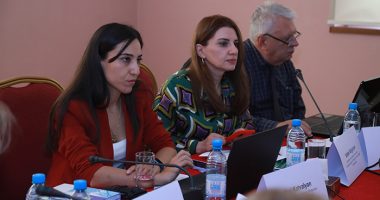By Lucine Kasbarian
In April 2013, the winners of the 4th Annual International Turkish Tourism Cartoon Competition will be announced.
The purpose of the competition is to “examine tourism” in Turkey by highlighting travelers’ experiences from a cartoonist’s point of view. The theme of this year’s competition is “the resident and tourist relationship.” Tourism is one of the biggest income-generating sectors of the Turkish economy.
Open to professional and amateur cartoonists around the world, the contest will award the winners a one-week vacation for two at a five-star hotel in Turkey.
The competition is co-sponsored by the Turkish Ministry of Tourism and Culture, the Turkish Association of Tourism Writers and Journalists, the Research Center for Caricature Art at Anadolu University, and the “Anatolia” Journal of Tourism Research. A representative of the Turkish Ministry of Tourism, Turkish cartoonists, two Turkish tourism journalists, and the editor of ”Anatolia” Journal serve as judges.
As a writer and cartoonist of Armenian descent, I am aware of the overtures made by Turkey to encourage tourism by Diasporan Armenians who may be interested in embarking on “nostalgia pilgrimages” to the regions from which their indigenous ancestors were driven during the Turkish government-perpetrated genocide of 1915-1923. Turkish officials and businessmen alike are clearly eager to derive tourism revenues from what they see as a natural target demographic, namely, the descendants of the forcibly exiled Armenians. After all, the Armenian Highland, now referred to as “Eastern Anatolia” or “Eastern Turkey” and virtually emptied of its Armenian population, is now one of Turkey’s most impoverished regions.
While Turkey desperately wishes to avoid the issue of reparations and restitution for the Armenian Genocide, one wonders whether the Turkish government is nevertheless experiencing cognitive dissonance as it invites Armenians to territory inhabited by their ancestors for more than 3,000 years. It must take a uniquely wired mind to self-justify the commission of mass murder, property theft and abduction while coaxing the descendants of the victims to cough up money for the “privilege” of touring the lands stolen from their parents, grandparents and forebears.
Turkey’s tourism outreach to Armenians reached unprecedented levels in 2010, after it purportedly “renovated” the 10th century Armenian Holy Cross Cathedral on Aghtamar Island on Lake Van.
Turkey announced that it expected thousands of tourists from Armenia and its Diaspora to spill into the Van region for the ostensibly auspicious opening of a monument that holds great historical, spiritual, and cultural significance for Armenians. A condition in Turkey’s gesture of “great tolerance” and “largesse” was that Holy Cross would be a house of worship no more, as the structure was to be only a state museum. Downplayed was the fact that ongoing Christian worship inside the structure would be forbidden.
We could, of course, discuss how unsafe Turkey is, not only to tourists but also to those indigenous groups who have been made to feel like outsiders. The murder of Armenians — from journalist Hrant Dink and defenseless old women in Istanbul to visitors in the resort town of Antalya — are but a few recent examples.
Armenians commemorate April 24 every year because on that day in 1915 the Turkish government rounded up and murdered hundreds of Armenian intellectuals and community leaders. The purpose was to eliminate the top echelon of the Armenian people and, thereby, to more easily dispose of the masses.
In recent decades, the Turkish government has reserved the month of April to publicly rehabilitate its genocidal reputation. Each year, Turkish Children’s Day and Turkish Cultural Month strategically commence on April 23rd. Significantly, the Tourism Cartoon Competition’s exhibition of finalists’ cartoons and its award ceremony are also to be held in April.
As Turkey’s genocide whitewashing campaigns continue unabated, it should come as no surprise that, “coincidentally” this April, the Eurasia Partnership Foundation, its co-sponsor, the United States Agency for International Development (USAID), and other organizations are bringing about direct passenger flights between Yerevan and Van even as Turkey continues to close its border with Armenia.
The title of this article – derived from the opening line of Mary Howitt’s famous poem – is intended to apply to Turkey’s overtures to tourists. The line is often used in popular culture to indicate an offer of friendship that is, in fact, a trap.
“Will you walk into my parlor?” said the Spider to the Fly,
’Tis the prettiest little parlor that ever you did spy;
The way into my parlor is up a winding stair,
And I’ve a many curious things to show when you are there.”
“Oh no, no,” said the little Fly, “to ask me is in vain,
For who goes up your winding stair —
Can ne’er come down again.”
— Mary Howitt, 1829
# # #
Lucine Kasbarian is a journalist, book publicist, children’s book author and political cartoonist.


Competition











1 comment
As Turkey just officially closed down Yerevan-Van flights, at least this will deny Turkey our Armenian tourist dollars for the chance to tour our own homes and property. We are being shown once again to not trust Turkey’s promises, just as in the Protocols.